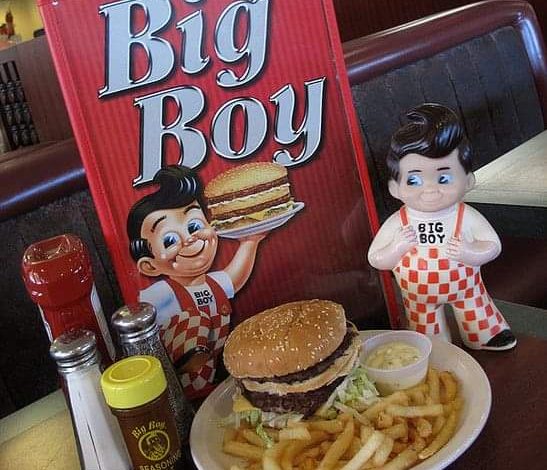
ADVERTISEMENT
Big Boy: An Icon of American Diner Culture
Introduction
The image of a Big Boy restaurant table, complete with the iconic statue, vibrant menu, and classic meal, takes us back to the golden age of American diners. Big Boy is more than just a burger chain; it is a cultural institution that has been delighting generations of customers since its inception in 1936. Known for its hearty double-decker burgers, retro decor, and cheerful mascot, Big Boy captures the essence of mid-20th-century Americana. This essay explores the history, appeal, and enduring legacy of Big Boy as a symbol of American dining nostalgia.
The Birth of Big Boy
Big Boy began as a humble burger stand in Glendale, California, founded by Bob Wian. His creation of the original double-decker hamburger, featuring two patties and a slice of bun in the middle, revolutionized the fast-food industry. Wian’s unique recipe quickly gained popularity, and the business expanded into a national franchise. The name “Big Boy” came from a young boy who frequented the stand and inspired Wian with his playful demeanor and appetite. The iconic mascot, wearing red-and-white checkered overalls, became the brand’s identity and a beloved figure across America.
A Diner Experience Like No Other
The Big Boy dining experience is rooted in the charm of classic diners. From the vinyl booths to the cheerful red-and-white decor, every element evokes a sense of comfort and nostalgia. The menu offers a variety of American comfort foods, with the double-decker burger as its crown jewel. Paired with golden fries and a side of creamy coleslaw, it’s a meal that epitomizes indulgence. For many, a trip to Big Boy is more than just eating—it’s about reliving memories of family dinners, road trips, and carefree times.
The mascot himself adds to the fun atmosphere. Often displayed as a statue near the entrance or on the table decor, he welcomes customers with his signature smile and cheerful pose. Over the decades, this friendly figure has become a symbol of joy and togetherness, resonating with both children and adults.
ADVERTISEMENT
Cultural Significance and Legacy
Big Boy has played a significant role in shaping America’s dining culture. As one of the first major fast-food chains, it set the stage for the boom of quick-service restaurants. Its innovative menu and marketing strategies have left an indelible mark on the industry. The chain’s expansion during the 1950s and 60s paralleled the rise of car culture, making it a popular destination for families and travelers.
Despite the evolution of dining trends, Big Boy has retained its loyal fanbase. Vintage enthusiasts and food lovers alike are drawn to its retro vibe and classic flavors. The mascot remains a cultural icon, often featured in pop culture references and collectible merchandise. Today, Big Boy serves as a nostalgic reminder of simpler times and the enduring appeal of classic American diners.
Conclusion
The Big Boy brand is a testament to the power of tradition, innovation, and nostalgia. From its humble beginnings to its status as an American cultural icon, it continues to delight customers with its timeless charm and delicious offerings. Whether it’s the iconic double-decker burger, the friendly mascot, or the warm diner atmosphere, Big Boy holds a special place in the hearts of many. As an enduring symbol of mid-century America, it reminds us that some traditions are worth preserving, one burger at a time.
ADVERTISEMENT




